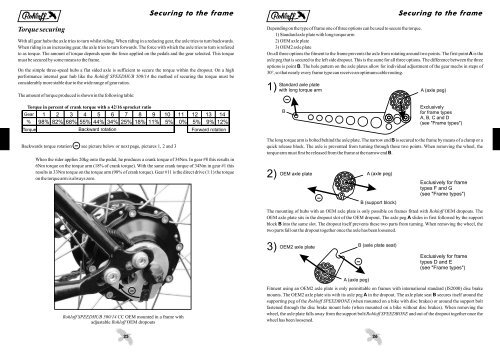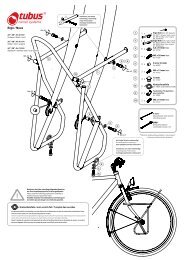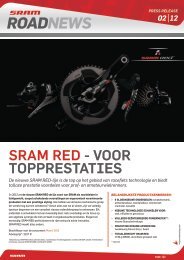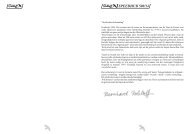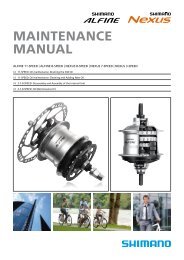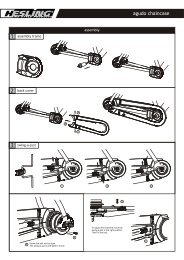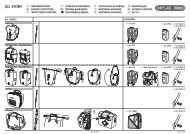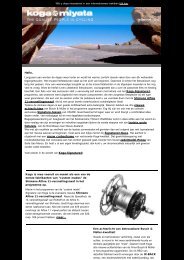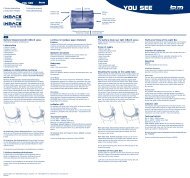You also want an ePaper? Increase the reach of your titles
YUMPU automatically turns print PDFs into web optimized ePapers that Google loves.
Torque securing<br />
With all gear hubs the axle tries to turn whilst riding. When riding in a reducing gear, the axle tries to turn backwards.<br />
When riding in an increasing gear, the axle tries to turn forwards. The force with which the axle tries to turn is refered<br />
to as torque. The amount of torque depends upon the force applied on the pedals and the gear selected. This torque<br />
must be secured by some means to the frame.<br />
On the simple three-speed hubs a flat sided axle is sufficient to secure the torque within the dropout. On a high<br />
performance internal gear hub like the Rohloff <strong>SPEEDHUB</strong> <strong>500</strong>/<strong>14</strong> the method of securing the torque must be<br />
considerably more stable due to the wide range of gear ratios.<br />
The amount of torque produced is shown in the following table:<br />
Torque in percent of crank torque with a 42/16 sprocket ratio<br />
Gear 1 2 3 4 5 6 7 8 9 10 11 12 13 <strong>14</strong><br />
% 98% 82% 68% 55% 44% 34% 25% 18% 11% 5% 0% 5% 9% 12%<br />
Torque<br />
Backward rotation<br />
Backwards torque rotation see picture below or next page, pictures 1, 2 and 3<br />
When the rider applies 20kg onto the pedal, he produces a crank torque of 34Nm. In gear #8 this results in<br />
6Nm torque on the torque arm (18% of crank torque).<br />
With the same crank torque of 34Nm in gear #1 this<br />
results in 33Nm torque on the torque arm (98% of crank torque). Gear #11 is the direct drive (1:1) the torque<br />
on the torque arm is always zero.<br />
Rohloff <strong>SPEEDHUB</strong> <strong>500</strong>/<strong>14</strong> CC OEM mounted in a frame with<br />
adjustable Rohloff OEM dropouts<br />
25<br />
Securing to the frame<br />
Forward rotation<br />
Depending on the type of frame one of three options can be used to secure the torque.<br />
1) Standard axle plate with long torque arm<br />
2) OEM axle plate<br />
3) OEM2 axle plate<br />
On all three options the fitment to the frame prevents the axle from rotating around two points. The first point A is the<br />
axle peg that is secured to the left side dropout. This is the same for all three options. The difference between the three<br />
options is point B.<br />
The hole pattern on the axle plates allow for individual adjustment of the gear mechs in steps of<br />
30°, so that nearly every frame type can receive an optimum cable routing.<br />
1)<br />
2)<br />
3)<br />
Standard axle plate<br />
with long torque arm<br />
B<br />
OEM axle plate A (axle peg)<br />
26<br />
Securing to the frame<br />
A (axle peg)<br />
Exclusively<br />
for frame types<br />
A, B, C and D<br />
(see "Frame types")<br />
The long torque arm is bolted behind the axle plate. The narrow end B is secured to the frame by means of a clamp or a<br />
quick release block. The axle is prevented from turning t hrough these two points.<br />
When removing the wheel, the<br />
torque arm must first be released from the frame at the narrow end B.<br />
Exclusively for frame<br />
types F and G<br />
(see "Frame types")<br />
The mounting of hubs with an OEM axle plate is only possible on frames fitted with Rohloff OEM dropouts. The<br />
OEM axle plate sits in the dropout slot of the OEM dropout. The axle peg A slides in first followed by the support<br />
block B into the same slot. The dropout itself prevents these two parts from turning. When removing the wheel, the<br />
two parts fall out the dropout together once the axle has been loosened.<br />
OEM2 axle plate<br />
A (axle peg)<br />
B (support block)<br />
B (axle plate seat)<br />
Exclusively for frame<br />
types D and E<br />
(see "Frame types")<br />
Fitment using an OEM2 axle plate is only permittable on frames with international standard (IS2000) disc brake<br />
mounts. The OEM2 axle plate sits with its axle peg A in the dropout. The axle plate seat B secures itself around the<br />
supporting peg of the Rohloff SPEEDBONE (when mounted on a bike with disc brakes) or around the support bolt<br />
fastened through the disc brake mount hole ( when mounted on a bike without disc brakes). When removing the<br />
wheel, the axle plate falls away from the support bolt/ Rohloff SPEEDBONE and out of the dropout together once the<br />
wheel has been loosened.


